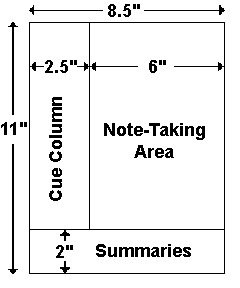The Cornell note taking system is a model of taking notes that was developed at the Cornell University by Walter Pauk. Pauk was an education professor at the university.
This model of taking notes was developed in the year 1954. The model was meant to aid students in the University by simplifying the study process. Pauk published this model of study in his famous book titled, “How to Study in College”. The Cornell note taking model of study seeks to ease studying by setting specifications to guide students in taking notes while studying (Sylvia, 27).
How the Cornell note taking system works
This model of learning gives a systematized way in which students can summarize and organize notes. An explanation is given on how the paper used in note taking by students ought to be structured to get maximum utility from study sessions. This is a major distinguishing factor between this model of study and other models. According to this model, the study or note taking paper can be structured as indicated below.

Source: “The Cornell System for Note-Taking”, p. 1
The three parts labeled in the diagram above are critical while studying. The note taking area is used in recording lectures. This has to be done using telegraphic sentences. After a class or learning session, students should formulate questions basing on the notes recorded in the note taking column.
Questions are important because they aid in making clarification to students concerning the meaning and relations of meanings in the notes. Questions also aid in broadening and strengthening memory of students. During the study for exams, these questions simplify revision work. The cue column is critical in recitation of the notes. During recitation, students are required to cover the note taking area fully. Students are required to recite the answers to the questions by looking at the questions in the question column.
This has to be said loudly depending on the level of understanding of the student. This leads to the reflection of the learning material, which is another important step in learning. This is achieved through a re-look at the facts that are raised through answers to the questions found in the study text (Sylvia, 27).
Questions asked during reflection include those on the relevance of the facts in the notes, principles informing the facts, the applicability of the facts, and their relationship with what the learner already knows. The question about what goes beyond the facts is of great relevance in reflection because they are brought out during learning.
Students are also required to keep reviewing previous notes. This has to be done for at least ten minutes each week. This keeps the facts in the notes fresh in the mind of students. The summary section is used at the end of the learning session. The notes on each page are summed in this section (Sylvia, 27).
This model of learning has been found to be very effective in different learning sessions. It is best suited in learning session that deal with broad theoretical concepts with numerous notes and information. Thus, it best suits my economics classes. The system is very effective because it focuses on the critical steps in learning like recording, recitation, reflection, and reviewing. However, the system is very comprehensive and can hardly be followed by students. It is quite tiring for anybody who chooses to follow it fully.
Works Cited
Sylvia, Behrmann. Practical Study Methods. New York: Gardners Books, 2007. Print.
The Cornell System for Note-Taking. 2010. Web.